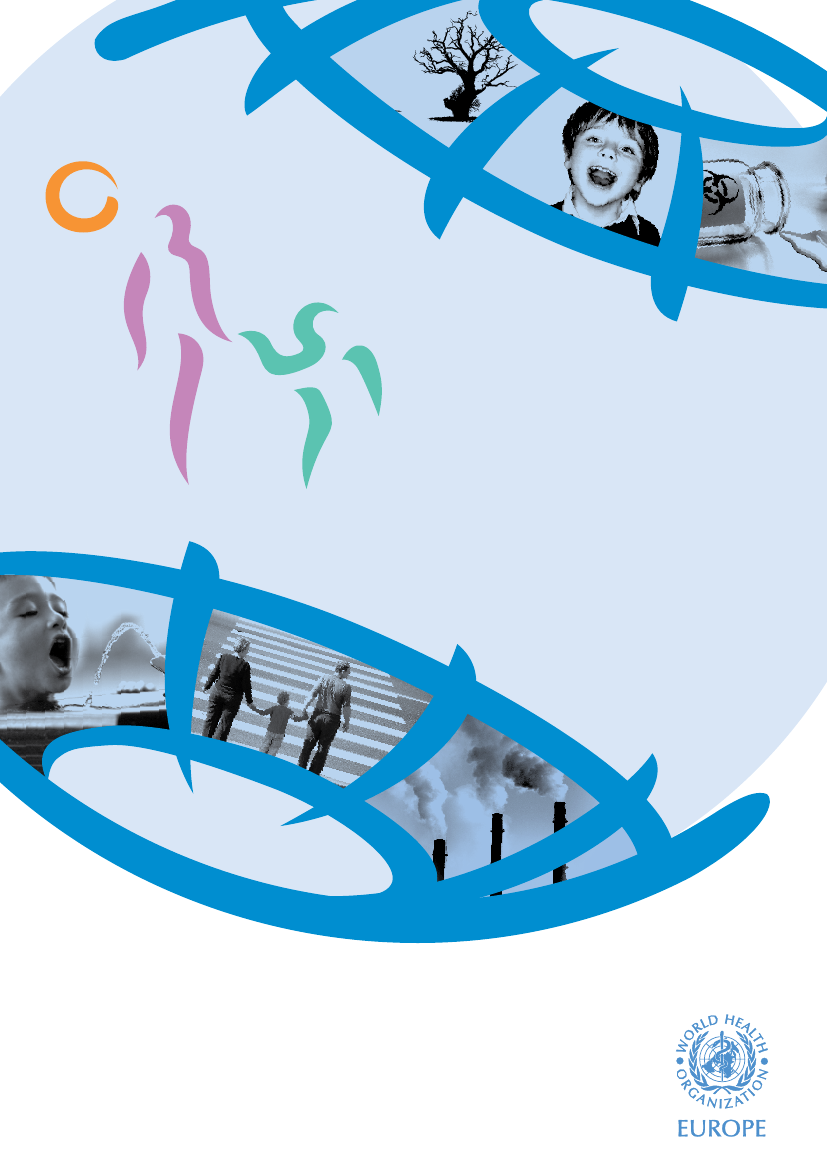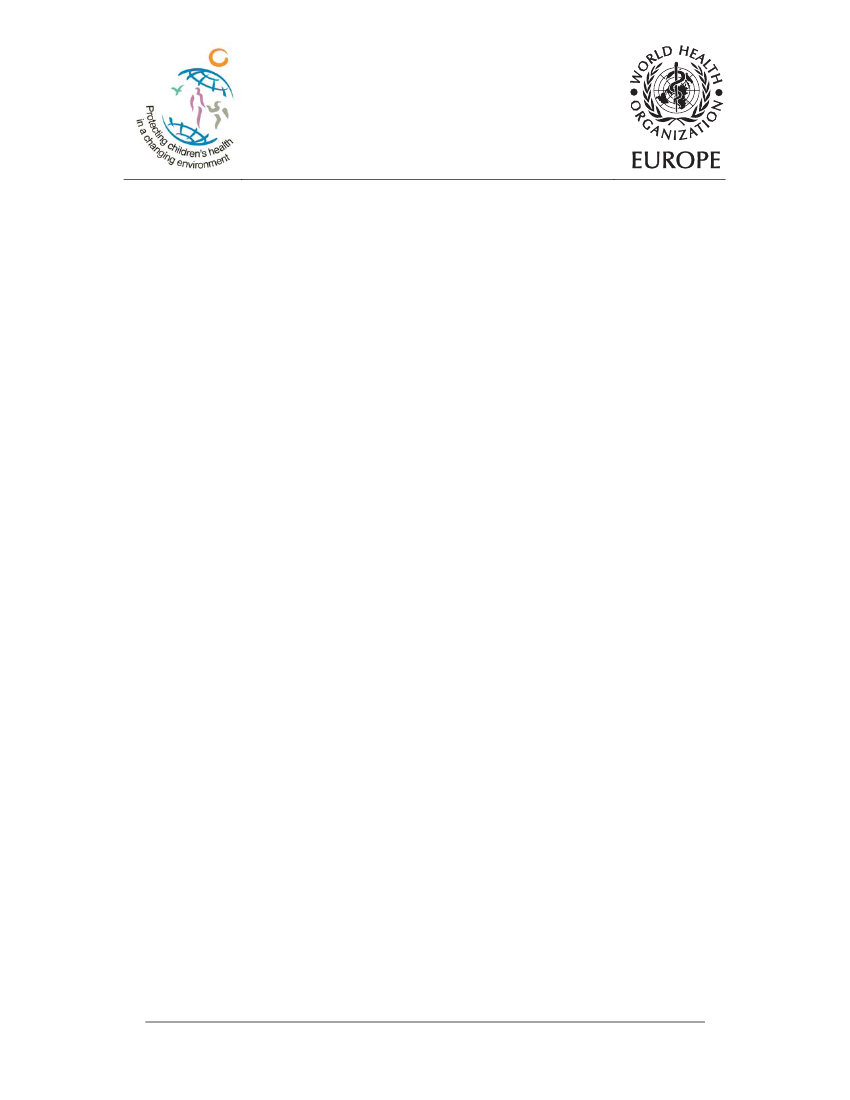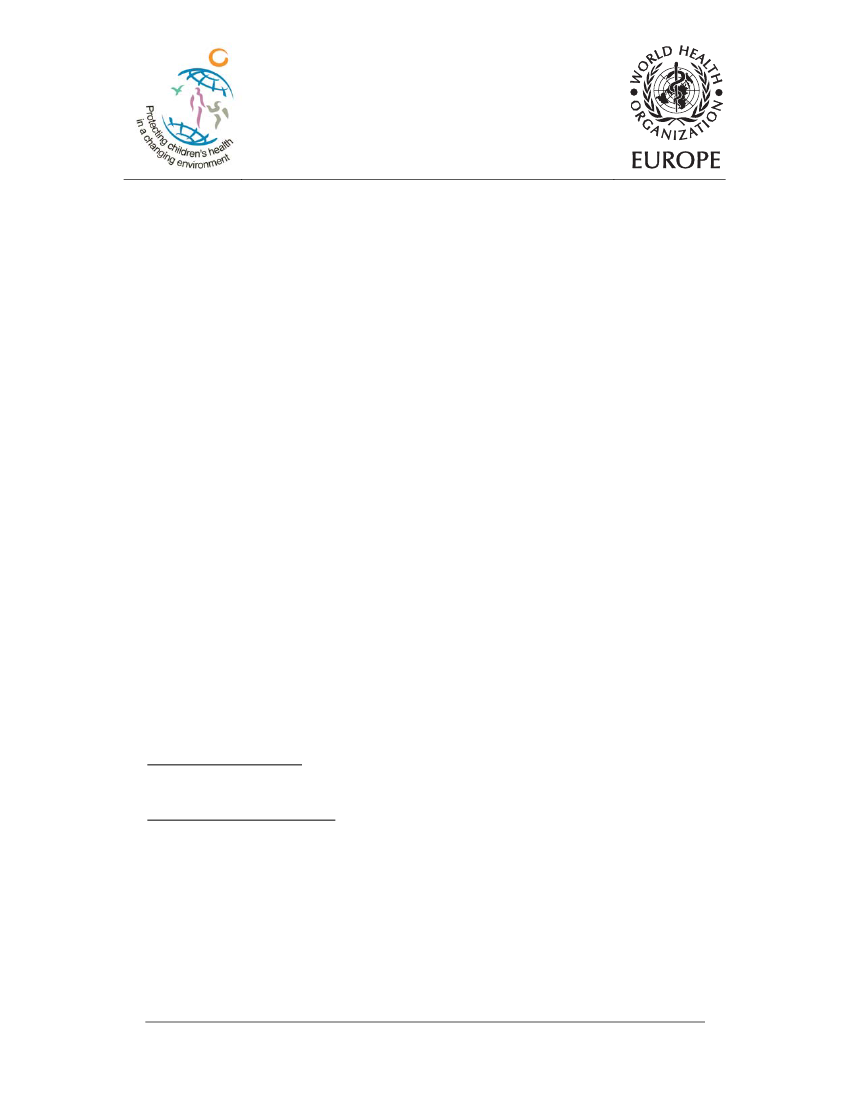Miljø- og Planlægningsudvalget 2009-10
MPU Alm.del Bilag 401
Offentligt
1
Parma Declaration onEnvironment and HealthFinal Draft 22 January 2010
Fifth Ministerial Conferenceon Environment and Health“Protecting children’s health in achanging environment”Parma, Italy, 10–12 March 2010EUR/55934/5.122 January 2010100101Original: English
Final DraftParma Declaration on Environment and Health1.We the Ministers and Representatives of Member States in the European Regionof the World Health Organization (WHO) responsible for health and the environment,together with the WHO Regional Director for Europe, in the presence of the EuropeanCommissioners for Health and Consumer Policy and for the Environment, the ExecutiveSecretary of the United Nations Economic Commission for Europe (UNECE) and theRegional Director for Europe of the United Nations Environment Programme (UNEP)have gathered in Parma, Italy from 10 to 12 March 2010 to face the key environmentand health challenges of our time.2.Building on the foundations laid in the European Environment and Health Processto date, we will intensify our efforts to implement the commitments made throughprevious WHO ministerial conferences, especially those set out in the Children’sEnvironment and Health Action Plan for Europe (CEHAPE).3.We are committed to act on the key environment and health challenges of ourtime. These include:(a)(b)the health and environmental impacts of climate change and related policies;the health risks to children and other vulnerable groups posed by poorenvironmental, working and living conditions (especially the lack of waterand sanitation);socioeconomic and gender inequalities in the human environment andhealth, amplified by the financial crisis;the burden of noncommunicable diseases, in particular to the extent that itcan be reduced through adequate policies in areas such as urbandevelopment, transport, food safety and nutrition, and living and workingenvironments;concerns raised by emerging issues such as persistent, endocrine-disruptingandbio-accumulatingharmfulchemicalsand[nanotechnologies/nanoparticles]; and
(c)(d)
(e)
Conference SecretariatWORLD HEALTH ORGANIZATION • REGIONAL OFFICE FOR EUROPEScherfigsvej 8, DK-2100 Copenhagen Ø, Denmark Telephone: +45 39 17 12 52/16 06 Fax: +45 39 17 18 78/18 92E-mail: [email protected] World Wide Web address: http://www.euro.who.int/parma2010
EUR/55934/5.1page 2
(f)
insufficient resources in parts of the WHO European Region.
4.We will address these challenges by setting up or strengthening existingmechanisms or structures that can ensure effective implementation, promote localactions and ensure active participation in the European Environment and HealthProcess. Recognizing that economic arguments are increasingly critical to developsound policies, we will pay special attention to fostering strategic partnerships andnetworks, so that environment and health issues are better integrated across the policiesof all sectors. We call on these sectors and relevant organizations to work with us moreclosely to ensure healthy environments.5.We will intensify efforts to develop, modify and implement health andenvironmental legislation and to continue health system reforms as necessary,particularly in the newly independent states and countries of south-eastern Europe,aimed at streamlining, upgrading and strengthening the performance of public healthand environmental services.6.We will ensure that youth participation is facilitated across all Member States atboth national and international levels by providing them with assistance, resources andthe training required for meaningful and sustainable involvement in all aspects of theprocess.7.We will advocate for investing in sustainable and environmentally friendly andhealth-promoting technologies, emphasizing the opportunities created by theseactivities, such as energy-efficient health services and green jobs.8.We encourage international stakeholders, including international financialinstitutions, and the European Commission to offer further scientific, political, technicaland financial assistance to help establish effective mechanisms and strengthen capacitiesto reduce exposures to environmental hazards and the resulting health impacts in theRegion.9.We call upon the WHO Regional Office for Europe, the European Commission,UNECE and UNEP to strengthen their collaboration to ensure progress in environmentand health implementation in the WHO European Region.10. We endorse and will implement the “Commitment to act” and the goals andtargets included therein. That document is an integral part of this Declaration.11. [We endorse the approach described in the “Future of the process”. We commenda stronger political role for the European Environment and Health Committee and wewill follow up on implementation through the Environment and Health Task Force andreport annually to the WHO Regional Committee for Europe.]12. We agree to meet again at the Sixth European Ministerial Conference onEnvironment and Health in [2015].
EUR/55934/5.1page 3
13. We the Minister of Health and the Minister of the Environment, Land and Sea ofItaly, on behalf of all the ministers of health and environment in the European Region ofWHO, together with the WHO Regional Director for Europe and in the presence of theEuropean Commissioners for Health and the Environment, hereby fully adopt thecommitments made in this Declaration.
_______________________Minister of Health, ItalyCo-president
________________________Minister of Environment, ItalyCo-president
_______________________Regional Director,WHO Regional Office for Europe
Fifth Ministerial Conferenceon Environment and Health“Protecting children’s health in achanging environment”Parma, Italy, 10–12 March 2010EUR/55934/5.222 January 2010100105Original: English
Commitment to ActBuilding on the foundations laid in the European Environment and Health Process todate, including in particular the Fourth Ministerial Conference on Environment andHealth and the Intergovernmental Mid-term Review held in Vienna in June 2007, wewill increase our efforts to address the key environment and health challenges of ourtime, including climate change, emerging issues and the effects of the economic crisis,and we reaffirm our commitment to work together across sectors.We recognize established political processes that ensure healthy environments forchildren, including all related United Nations processes, other WHO ministerialconferences as well as European Union legislation and the 2009 deliberations of theGroup of Eight industrialized nations (G8), as tools for further implementation.1We take particular note of the Declaration of the Sixth Ministerial Conference“Environment for Europe”, of WHO’s Tallinn Charter on Health Systems, Health andWealth2and of the European Union Declaration on Health in All Policies.
A. Protecting children’s health1.We reconfirm our commitment to prioritized actions under the regional priority goals(RPGs) in the Children’s Environment and Health Action Plan for Europe (CEHAPE) asindicated below. We will strive to attain the targets in the RPGs as set out below.
Regional Priority Goal 1water and sanitation
Ensuring public health by improving access to safe
Turkey declares that it does not consider itself bound by the commitments and undertakings in theparagraphs related to international treaties, conventions or protocols to which it is not a contracting party,namely the Protocol on Water and Health to the 1992 Convention on the Protection and Use ofTransboundary Watercourses and International Lakes and the Protocols to the 1979 Convention on Long-Range Transboundary Air Pollution except the 1984 Protocol on Long-Term Financing of theCooperative Programme for Monitoring and Evaluation of the Long-range Transmission of Air Pollutantsin Europe.2Within the political and institutional framework of each country, a health system is the ensemble of allpublic and private organizations, institutions and resources mandated to improve maintain or restorehealth. Health systems encompass both personal and population services, as well as activities to influencethe policies and actions of other sectors to address the social, environmental and economic determinantsof health.Conference SecretariatWORLD HEALTH ORGANIZATION • REGIONAL OFFICE FOR EUROPEScherfigsvej 8, DK-2100 Copenhagen Ø, Denmark Telephone: +45 39 17 12 52/16 06 Fax: +45 39 17 18 78/18 92E-mail: [email protected] World Wide Web address: http://www.euro.who.int/parma2010
1
EUR/55934/5.2page 2
i.
We will take advantage of the approach and provisions of the Protocol onWater and Health3as a rationale and progressive tool to develop integratedpolicies on water resource management and health, addressing thechallenges to safe water services posed by climate change, with clear targetsand objectives, working in partnership with all concerned sectors.We will strive to provide each child with access to safe water and sanitationin homes, child care centres, kindergartens, schools, health care institutionsand public recreational water settings by 2020, and to revitalize hygienepractices.and
injuries
through
safe
ii.
Regional Priority Goal 2Addressing obesity
environments, physical activity and healthy diet
i.
We will implement the relevant parts of the commitments set out in theAmsterdam Declaration of the Third High-Level Meeting of the TransportHealth and Environment Pan-European Programme (THE PEP).We will integrate the needs of children into the planning and design ofsettlements, housing, health care institutions, mobility plans and transportinfrastructure. To this end we will use health, environment and strategicimpact assessments and we will develop and adapt the relevant regulations,policies and guidelines, and implement the necessary measures.We will work in partnership with local, regional and national authorities toadvocate for actions to counteract the adverse effects of urban sprawl thatcause socioeconomic, health and environmental consequences.We aim to provide each child by 2020 with access to healthy and safeenvironments and settings of daily life in which they can walk and cycle tokindergartens and schools, and to green spaces in which to play andundertake physical activity. In so doing, we intend to prevent injuries byimplementing effective measures and promoting product safety.We will implement the WHO European Action Plan for Food and NutritionPolicy (2007–2012), in particular by improving the nutritional quality ofschool meals, and support local food production and consumption, where itcan reduce environmental and health impacts.Preventing disease through improved outdoor and
ii.
iii.
iv.
v.
Regional Priority Goal 3indoor air quality
i.
We will take advantage of the approach and provisions of the protocols tothe 1979 Convention on Long-Range Transboundary Air Pollution and wewill support their revision. We will continue and enhance our efforts todecrease the incidence of acute and chronic respiratory diseases throughreduction of exposure to ultrafine particles and other particulate matter,especially from industry, transport and domestic combustion, as well asground-level ozone, in line with WHO’s air quality guidelines. We willstrengthen monitoring, control and information programmes, includingthose related to fuels used in transport and households.
Protocol on Water and Health to the 1992 Convention on the Protection and Use of TransboundaryWatercourses and International Lakes.
3
EUR/55934/5.2page 3
ii.
We will develop appropriate cross-sectoral policies and regulations capableof making a strategic difference in order to reduce indoor pollution, and wewill provide incentives and opportunities to ensure that citizens have accessto sustainable, clean and healthy energy solutions in homes and publicplaces.We aim to provide each child with a healthy indoor environment in childcare facilities, kindergartens, schools and public recreational settings,implementing WHO’s indoor air quality guidelines and, as guided by theFramework Convention on Tobacco Control, ensuring that theseenvironments are tobacco smoke-free by 2015.
iii.
Regional Priority Goal 4Preventing disease arising from chemical, biological
and physical environments
i.We will take advantage of the approach and provisions of relevantinternational agreements.4We will contribute to the Strategic Approach toInternational Chemicals Management (SAICM) and to the development ofthe global legal instrument on mercury.We aim to protect each child from the risks posed by exposure to harmfulsubstances and preparations, focusing on pregnant and breast-feedingwomen and places where children live, learn and play. We will identifythose risks and eliminate them as far as possible, [by 2015/2020].We will act on the identified risks of exposure to carcinogens, mutagens andreproductive toxicants, including radon, ultraviolet radiation, asbestos andendocrine disruptors, and urge other stakeholders to do the same. [Inparticular, unless we have already done so, we will ban asbestos inconstruction materials and other products by 2015./We will eliminateasbestos-related diseases.]We call for more research into the potentially adverse effects of persistent,endocrine-disrupting and bio-accumulating chemicals and theircombination, as well as for the identification of safer alternatives. We alsocall for an increase of research into the use of nanoparticles in products andnanomaterials, and electromagnetic fields, in order to evaluate possibleharmful exposures. We will develop and use improved health risk andbenefit assessment methods.We call upon all stakeholders to work together to reduce children’sexposure to noise, including that from personal electronic devices,recreation and traffic, especially in residential areas, at child care centres,kindergartens, schools and public recreational settings. We urge and offerour assistance to WHO to develop suitable guidelines on noise.
ii.
iii.
iv.
v.
Such as the Basel Convention on the Control of Transboundary Movements of Hazardous Wastes andtheir Disposal, the Rotterdam Convention on the Prior Informed Consent Procedure for CertainHazardous Chemicals and Pesticides in International Trade, and the Stockholm Convention on PersistentOrganic Pollutants, as well as the protocols on heavy metals and on persistent organic pollutants to the1979 Convention on Long-Range Transboundary Air Pollution.
4
EUR/55934/5.2page 4
vi.
We will pay particular attention to child labour and exploitation as one ofthe major settings of exposure to relevant risks, and especially to hazardouschemicals and physical stressors.
B. Protecting health and the environment from climate change2.We are committed to protecting health and well-being, natural resources andecosystems and to promoting health equity, health security and healthy environments ina changing climate. Taking into account the ongoing work under the United NationsFramework Convention on Climate Change and recognizing subregional,socioeconomic, gender and age variability, we will:i.integrate health issues in all climate change mitigation and adaptationmeasures, policies and strategies at all levels and in all sectors. We willassess, prevent and address any adverse health effects of such policies by,for example, strengthening health promotion in environmental policies;strengthen health, social welfare and environmental systems and services toimprove their response to the impacts of climate change in a timely manner,for example to extreme weather events and heat waves. In particular, wewill protect the supply of water and the provision of sanitation and safe foodthrough adequate preventive, preparedness and adaptive measures;develop and strengthen early warning surveillance and preparedness systemsfor extreme weather events and disease outbreaks, for example vector-bornediseases, at the animal-human-ecosystem interface, where appropriate;develop and implement educational and public awareness programmes onclimate change and health, to encourage healthy, energy-efficientbehaviours in all settings and provide information on opportunities formitigation and adaptation interventions, with a particular focus onvulnerable groups and subregions;collaborate to increase the health sector’s contribution to reducinggreenhouse gas emissions and strengthen its leadership on energy- andresource-efficient management and stimulate other sectors, such as the foodsector, to do the same;encourage research and development, for example with tools for forecastingclimate impacts on health, identifying health vulnerability and developingappropriate mitigation and adaptation measures.
ii.
iii.
iv.
v.
vi.
3.We call on the WHO Regional Office for Europe, in collaboration with theEuropean Commission, the European Environment Agency, the United NationsEconomic Commission for Europe, the United Nations Environment Programme andother partners, to set up European information platforms for systematic sharing of bestpractices, research, data, information, technology and tools focused on health at alllevels.4.We welcome the regional framework for action entitledProtecting health in anenvironment challenged by climate change.We recommend that the approachesdescribed in it are used to support action in this area.
EUR/55934/5.2page 5
C. Involvement of children, young people and other stakeholders5.We will ensure that youth participation in national as well as internationalprocesses is facilitated across all Member States by providing them with assistance,adequate resources and the training required, and by giving them opportunities formeaningful involvement.6.We will increase our cooperation with local and subnational authorities,intergovernmental and nongovernmental organizations, the business community, tradeunions, professional associations and the scientific community, drawing on theirexperience and knowledge in order to achieve the best possible results.7.We call on the business community to address the challenges posed in thisCommitment, for instance through relevant corporate and sectoral programmes.8.We will seek to improve knowledge of environment and health issues and buildthe capacity of all professionals, with particular emphasis on health professionals andprofessional caretakers of children.
D. Knowledge and tools for policy-making and implementation9.We support the development of the European Environment and HealthInformation System (ENHIS). We call on the WHO Regional Office for Europe, andalso on the European Commission and the European Environment Agency to continueto assist Member States with the development of internationally comparable indicators,and to assist in the interpretation and practical application of relevant research results.10. We encourage all relevant international organizations to further develop commontools and guidelines to address the economic impacts of environmental risk factors tohealth, including the cost of inaction, thereby facilitating the development andenforcement of legal instruments.11. We will contribute to develop a consistent and rational approach to humanbiomonitoring as a complementary tool to assist evidence-based public health andenvironmental measures, including awareness-raising for preventive actions.12. We acknowledge the contributions, conclusions and recommendations of theInternational Public Health Symposium on Environment and Health Research held inMadrid in October 2008. We agree to secure support for interdisciplinary research inline with the policy objectives of this Declaration and to improve the development ofidentified tools,5including health impact assessment. We will use existing informationfor policy-making and apply the precautionary principle where appropriate, especiallyin respect of new and emerging issues.
Such as the Protocol on Strategic Environmental Assessment to the Convention on EnvironmentalImpact Assessment in a Transboundary Context.
5
EUR/55934/5.2page 6
13. We affirm the need for participation of the public and stakeholders in tacklingenvironment and health issues. We will develop and implement initiatives on riskperception, assessment, management and communication.











